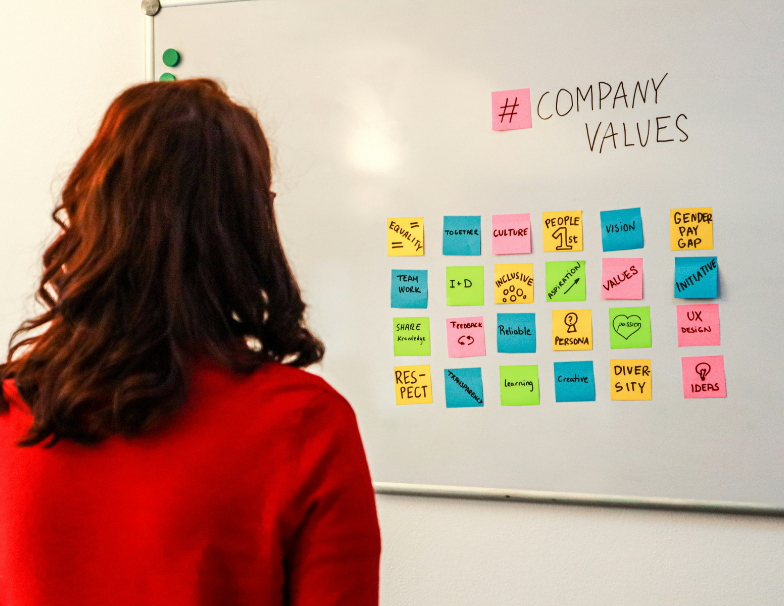ERG: Employee Resource Groups Definition, Benefits & Examples
.png)
ERG: Employee Resource Groups Definition, Benefits & Examples

A strong group of employees is what makes a company succeed. Trustworthy, loyal, and hardworking employees are, in fact, the most important factor in the prosperity and growth of any business.
That’s why it’s important to help the employees move up in their personal lives as well as in their careers. In order to achieve this, companies have started founding employee resource groups and supporting employees who want to create them. These business resource groups focus on fostering diversity, inclusion, and community among employees, which in turn promotes professional development and employee engagement.
If you don’t know what employee resource groups are, then you might want to read this article until the very end. We will not only talk about what they are and how important they can be, but we’ll also give you some examples of successful companies that have well-established ERGs.
What is an Employee Resource Group?

Employee resource groups, or ERGs, are voluntary employee led groups. Their purpose is to help workers grow both personally and professionally.
ERGs are meant to be a safe space where employees can talk about their experiences, give advice, seek help, and change their workplace environments for the better in general.
History of Employee Resource Groups
Originally known as workplace affinity groups, ERGs were made as a response to racial tension in the United States in the 1960s.
The National Black Employees Caucus, an employee resource group (ERG), was started in 1964 by Xerox’s former CEO, Joseph Wilson, and the company’s black employees. This was the first example of an ERG that gave black employees who had been treated unfairly at work a chance to talk about it and try to make things better.
Even though employee resource groups started in the U.S., companies around the world began doing the same thing. ERGs have grown and changed over the years. Now, they don’t just focus on identity groups but also on people who have shared experiences with matters such as health, parenting, protecting the environment, and so on.
Types of Employee Resource Groups
Most organizations have a few different types of employee resource groups. For bigger companies, there can be as many as 10 or 12 ERGs, and while some of them are unique, others are rather common.
ERGs are most often created by minorities within the company or by employee groups who possess some common traits. Some of the most popular themes these groups are based on are:
- Culture or ethnicity
- Disability
- Gender
- Religion
- Sexual orientation
- Age
- Single parenting
- Caregiving
There are also ERGs that are classified as affinity groups since they are based on shared interests rather than common traits. Examples of such affinity groups are those that focus on volunteering, health, or the environment.
The Purpose and Importance of Employee Resource Groups

Employee resource groups are all about strengthening the workplace community by providing opportunities for self-improvement and fostering an inclusive and positive company culture through a diverse workforce.
Some of the most common ERG goals are:
- Providing a safe place for employees to support each other and strengthen their sense of belonging to a workplace community
- Ensuring both financial and organizational help and making it easy to talk to the company’s decision-makers
- Having the chance to voice concerns and find solutions to problems
As you can see, employee resource groups have a lot of benefits for employees, but they are also very important for leadership roles—one of them being the opportunity to provide valuable leadership activity ideas. Without these groups, it would be hard for the executives to know what problems the employees are experiencing and what needs to be fixed for their work performance to improve.
Top 3 Company Benefits of Employee Resource Groups

As we were just on the topic of the advantages ERGs bring to organizations, here are the top 3 company benefits of employee resource groups.
ERGs Improve Employee Experience
Employee resource groups help create a culture of feedback, which has a direct effect on working conditions and, in turn, on employee experience. They also provide a safe space for asking corporate culture questions, encouraging open dialogue and continuous improvement. Encouraging new hires to join ERGs, known as erg participation, can significantly enhance their integration into the company culture and improve overall employee engagement.
If a company is known for its good employee experience, chances are they will get more high-quality job candidates and better partnership opportunities.
Moreover, ERGs are also a way for large teams to bond. Employees can spend time with one another in a less formal setting, which helps them form deeper connections and develop better collaborative skills through effective activities designed to strengthen team dynamics.
This, in turn, guarantees the company’s success, as the employees who create a well-integrated team encounter fewer instances of miscommunication and can thus deliver better results.
ERGs Promote Cultural Awareness
ERGs aim to promote an inclusive workplace where each employee is treated fairly and with respect.
Since this requires everyone to have some culture-specific knowledge, they often organize programs and workshops that help group members promote cultural awareness, set an ideal business culture example, and benefit from community support and professional development opportunities.
A company that has employees who are culturally knowledgeable is more likely to be efficient in problem-solving and internal communication. These characteristics are essential for the team to produce quality work and help the company succeed.
ERGs Can Improve Company Innovation
Another perk of founding ERGs is getting to lay the groundwork for more innovation in a company. Since employee resource groups bring together people with similar interests or experiences, they provide employees with an opportunity to come up with offsite ideas and turn them into real products.
This kind of innovation is good for the company because it leads to interesting projects that give them a better name and enable them to work with other important companies in the field.
Top 3 Employee Benefits of Employee Resource Groups

Companies are not the only ones benefiting from employee resource groups. In fact, ERGs bring plenty of benefits to employees and their development.
ERGs Help Build Professional Networks
Since ERGs are made up of employees from different backgrounds, they enable underrepresented employees to engage with employees who have more knowledge, experiences, and opportunities.
One such opportunity can be a mentorship program run by a person in a leadership position. If a junior employee takes advantage of this kind of opportunity, they will start to move up the career ladder.
ERGs Foster Employee Support
The whole point of employee resource groups is to help each other succeed in personal and professional endeavors by:
- Working together on a project
- Giving feedback on a specific task
- Offering mentoring services
- Letting people know about career opportunities
- Voicing concerns
- Finding solutions to existing problems
To elevate your team building and networking experience, consider incorporating purposeful activities that encourage collaboration, spark meaningful conversations, and foster a strong sense of community through Offsite.
ERG Members Can Gain Visibility
Employees who are part of ERGs can come from various organizational levels. This means that junior-level employees will have the opportunity to connect with employees in higher positions, including leadership roles. Needless to say, this type of networking can expose them to various opportunities for future career development.
How Can an Organization Support Employee Resource Groups

Now that you know why employee resource groups are beneficial for both companies and employees, let’s see how employers can actually support these groups and help them grow as business units:
- Be transparent about ERG. ”Honesty is the best policy” is a phrase you have probably heard before. Well, it works for almost everything, including employee resource groups. The company should be clear about what their ERGs’ goals are, who is in those groups, what kinds of activities are taking place, and so on. This kind of transparency will only add to the organization’s and the ERGs’ credibility.
- Appoint an executive sponsor. Having an executive sponsor for ERGs is crucial. An executive sponsor can influence organizational culture and business decisions, ensuring that diverse voices within these groups are heard and supported. This support can significantly enhance the development of inclusive environments.
- Create ERG policies. Any institution or group that wants to work well needs to have rules in place. Policies will only make sure that everyone in the group is treated with respect and that everyone gets the most out of it.
- Allow inclusivity for employees. The employer needs to make sure that all employees can join existing ERGs. Making everyone feel welcome will only enhance their sense of belonging, which will improve the overall work performance of the company.
- Facilitate networking among different ERG groups. The connection between different ERGs can only be a good thing. Not only does it improve the employees’ knowledge and experience with groups that have the same focus, but it also enables them to learn about new things from groups that focus on other topics.
- Hire diverse people. Diverse teams are good teams because they give their members a chance to learn more about different organizational cultures, ethnicities, and backgrounds. So, hiring people from different backgrounds can only be beneficial for ERGs and their growth, too.
- Encourage new hires to join the existing ERGs. Employers should always inform new employees of the existing ERGs and allow them to choose which ones they want to join.
ERG Best Practices: How to Start
Align with Company Goals
Aligning your ERG with company goals is crucial for its success. This ensures that the ERG’s objectives are in harmony with the organization’s overall mission and vision. ERG leaders should work closely with company leadership to understand the organization’s strategic objectives. This collaboration helps the ERG focus on initiatives that support key areas such as diversity and inclusion, employee engagement, and talent development. By aligning with company goals, ERGs can contribute to a more cohesive and unified company culture, ultimately driving the organization forward.
Executive Support
Executive support is essential for the success of an ERG. Having executive sponsors can provide the necessary guidance, resources, and visibility to amplify the ERG’s impact. ERG leaders should engage with executive sponsors to ensure that the ERG’s objectives align with the company’s goals and that the group has the resources needed to achieve its aims. Executive sponsors can help raise the ERG’s visibility within the organization, encouraging greater employee support and participation—sometimes even by incorporating games for team engagement. This top-down support is vital for the ERG’s sustainability and effectiveness.
ERG Team
Building a strong ERG team is critical to its success. ERG leaders should focus on recruiting members from underrepresented groups to ensure the team is diverse and inclusive. A well-rounded ERG team should have a clear understanding of the organization’s goals and be committed to achieving them. It’s also important that the team possesses the necessary skills and expertise to drive the ERG’s initiatives. By fostering a diverse and inclusive culture within the ERG, leaders can create a supportive environment that encourages personal and professional development for all members. Incorporating top corporate ideas—like mentorship programs, recognition initiatives, and games for team engagement—can further strengthen connection and collaboration within the group.
ERG Initiatives: Strategies for Success
Mentoring Programs
Mentoring programs are a key initiative for ERGs to support the career development of underrepresented groups. These programs can pair employees from underrepresented groups with senior leaders or mentors who can provide guidance and support. This not only helps increase diversity and inclusion within the organization but also supports the personal and professional development of underrepresented employees. Therefore, when running mentoring programs, it is also important to include activities that promote better team engagement. Additionally, ERGs can establish reverse mentoring programs, where employees from underrepresented groups mentor senior leaders on diversity and inclusion issues. This two-way learning process can foster a more inclusive culture and enhance the overall company culture.
4 Examples of Companies With Employee Resource Groups
After considering the ways in which organizations can support employee resource groups, it's time to look at some employee resource group examples in several well-known companies.
Dow
Dow is a sustainable materials science company that takes pride in being innovative and focused on its customers. With ten employee resource groups and more than 186 chapters around the world, the company is known for being inclusive.
Their employees can choose to join one of the following ERGs:
- Women's Inclusion Network
- Global African Affinity Network
- Asian Diversity Network
- Disability Employee Network
- Hispanic Latin Network
- GLAD: LGBTQ+ ERG
- Middle East-North Africa Intercultural Network
- Veterans Network
- RISE: new employee integration resource group
- PR!ME: resource group for recognizing mature employees
Humana
Humana is a company that sells health insurance plans to individuals and groups. What sets it apart from its competitors is its focus on inclusion and diversity. The company has ten active employee resource groups at the moment, namely:
- Disability Network Resource Group
- Caregivers Network Resource Group
- Multi-generational Network Resource Group
- Asian/Pacific Islander Network Resource Group
- African-American Network Resource Group
- Native American & Indigenous NRG
- Pride LGBTQ Associates & Allies Network Resource Group
- Veterans Network Resource Group
- Hispanic/Latino Network Resource Group
- Women's Network Resource Group
Accenture
Accenture tries to promote equality in the workplace for its 721,000 employees around the world. Along with specialized training, flexible schedules, and equal pay, the company ensures various employee resource groups to help its employees grow.
Some of their ERGs focus on mental health and wellness, disabilities, the LGBTQ+ community, ethnic and racial diversity, and gender equality.
Microsoft
As you may already know, Microsoft Corporation is the biggest software company in the world. Microsoft puts a lot of value on empowerment, as they believe that every individual and organization plays an active role in innovating for inclusivity. As such, they also incorporate engaging and innovative team building activities.
So far, Microsoft has nine large employee resource groups to help with this commitment, namely:
- Blacks at Microsoft (BAM)
- Disability at Microsoft
- The Global LGBTQIA+ Employees and Allies at Microsoft (GLEAM)
- Military at Microsoft
- Asians at Microsoft
- Families at Microsoft
- The Hispanic/Latinx employee resource group (HOLA)
- Women at Microsoft
- Indigenous community
Challenges of Employee Resource Groups

While employee resource groups are great for promoting self-improvement and career advancement, not all of them are capable of reaching that goal. This is largely due to the number of challenges that such groups often face.
Here are some of the most common problems they may encounter:
- ERG members don't see eye-to-eye. Being in a group with people from different backgrounds brings up a question—will everyone on the team get along? Most of the time, all employees can find something they agree on with others, but there is always a chance that their ideas and goals won't match up. When this happens, the work can't move forward, and the group can't advance either.
- There are no monetary rewards. Since ERGs are purely voluntary, there are no financial benefits to joining. Even if money isn't the reason why an employee joins a resource group, it would certainly make them more engaged and less likely to leave.
- Loss of momentum. When ERG is newly established, it may be the talk of the town, but as time goes by, loss of momentum becomes a stronger possibility. Employees can easily get distracted, focus more on their jobs, and lose motivation to participate in the group.
- Employees hold back from sharing. ERGs are meant to enable employees to talk about their problems, share their experiences, and look for solutions. Not all employees may feel this way, though. Some may hold back from sharing things just because they do not believe that ERGs are a safe space for such conversations. This kind of mindset will only make things hard for the group, as it will not be able to reach its full potential.
- Absence of the right tools. Without the right tools, ERGs won't be able to do well. For example, if there isn't a catalog or database that lists ERGs, it's less likely that employees will find them and join them. Also, if the group leaders don't have the right tools for managing the group, they may need to put more effort into doing so without them. This means they won't have as much time for the more important things, like coming up with a strategy.
How to Start an Employee Resource Group

If you would like to start an employee resource group, then you should go through these four stages:
- Find out if enough employees are interested in joining the group. ERGs are voluntary groups that are led by employees. For an ERG to work well, employees must be interested and motivated. You can even put together a group of employees who are willing to help you create the ERG.
- Set up a meeting with the company's leadership to make your case. You need to be ready to show why this kind of group is important. You should also present your game plan and ask to allocate some funds to carry out the employee resource group activities.
- Once the company's leaders give you the go-ahead, you can start looking for new members.
- Afterward, you'll be ready to hold your first meeting. At that meeting, you'll talk about the mission, goals, and planned activities and give people a chance to give feedback.
Don't forget to keep up with company support. Even if ERGs are run by employees, you still need the company's support, be it monetary or organizational.
ERGs Help Build Company Culture, But Offsite Can Help, Too!
In addition to creating employee resource groups, you can build corporate culture by hosting an offsite for your employees.
Such events can be a real treat for your workers. On top of promoting team building, conflict resolution, and productivity, company retreats are also a great way for your employees to relax, take a break, and have lots of fun together.
If you've never planned a company retreat before, there's no need to worry— Offsite is here to help! We will take care of everything, starting from choosing the venue based on your wishes and inviting guests to getting your employees' feedback after the retreat. All you have to do is tell us what the goals of your offsite are, how much you want to spend on it, how many people you want to invite, and where you want to host the retreat.
Once you do, we turn your ideas into action—all that remains is to relax and enjoy the event with your coworkers! Contact us with any questions you may have, and our team will help you organize the work retreat of your dreams.
Now you know what to do next—visit our website and start planning your next company retreat in no time!
Closing Thoughts
After reading this article, you should know all there is to know about employee resource groups, including definitions, benefits, and some amazing real-life examples.
ERGs are an indicator that employees and company leaders want to support one another's personal growth and career development. Even though they might face different problems along the way, they are sure to succeed if they have the right motivation and work together.
FAQs
You may also like
Unique spaces for your next offsite
Find distinctive venues for your upcoming corporate retreat.
Stay Updated with Our Insights
Get exclusive content and valuable updates directly to you.







